
Angel is Airborne
Aboard
Air Force One—during one of
America
’s most searing, perilous moments—a government was formed and a presidency
begun.
Part
II: In the Air
CHAPTER 8
The
world had barely kept up with Lyndon Johnson in the turmoil following the
shooting. For nearly an hour after Walter Cronkite announced on CBS that Kennedy
was dead, the public had no idea where Johnson was. Reporters heard only that he
would take the oath of office at Love Field at 2:35 pm, just three minutes
before Judge Hughes swore him in. By the time word spread that Johnson had taken
the oath officially as President, Air Force One was already flying back to
Washington—the country’s new chief executive out of reach and out of sight
for two seemingly interminable hours.
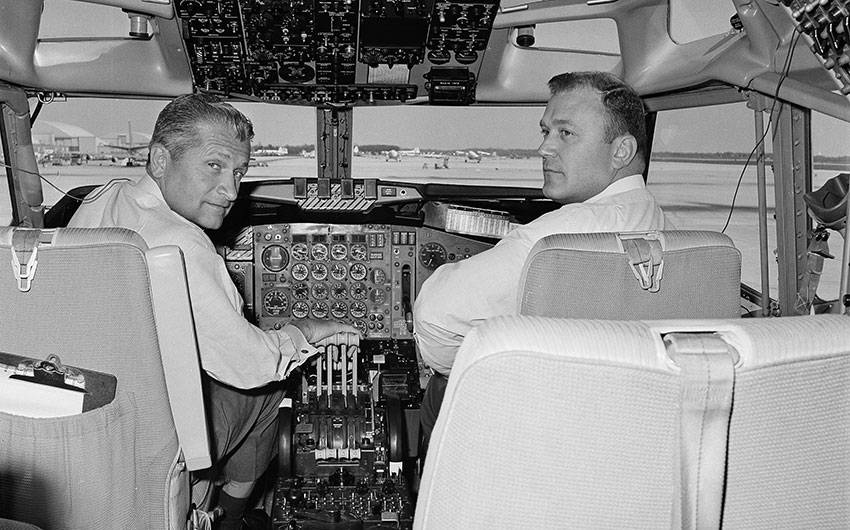
President
John F. Kennedy's pilot, Col. James B. Swindal, and co-pilot Maj. Lewis
"Swede" Hanson, check Air Force One's cockpit before take-off at
Andrews Air Force Base on May 13, 1963. (AP Photo/John Rous)
Nor
did anyone on earth know who was and was not aboard Air Force One. No list had
been left behind in
At
one point, well after Air Force One’s departure from
“Air
Force One—this is the Air Force Command Post,” the radio squawked. “If
possible, request the names of the passengers onboard, please.”
“We
have 40-plus,” the plane responded.
“Forty
people! Is that affirmative?”
“Affirmative.”
“Can
you tell me in regard to number one and number two—the top people?”
“Roger,”
Air Force One explained. “The President is onboard. The body is onboard, and
Mrs. Kennedy is onboard.”
Never
before or since has Air Force One carried two Presidents at once—one dead, one
alive. Never before or since has a Vice President witnessed the murder of his
President. Never before or since in the nuclear age has an assassination forced
the government into a panicked transition from one chief executive to another.
And never before or since have the aides of the fallen President and the
incoming President been locked together for hours in an aluminum tube, with one
another and their own thoughts.
In
fact, we may never know precisely how many people were aboard Air Force One as
it took off for
Scrawled
at the bottom of the page by a hand obviously unsure where to place such a
tragic piece of information are words that make a reader pause: “Also body of
Pres. K—.”
Normally
there would have been as many as a dozen Air Force staff on the plane, including
the three-person cockpit crew—the pilot, copilot, and flight
engineer—stewards, and a baggage master as well as members of the White House
Communications Agency, responsible for the plane’s communications.
The
Secret Service’s official manifest, recreated in February 1964 by Roy
Kellerman, one of the agents aboard, lists the 13 crew members the Secret
Service believes were onboard “for the entire trip to
Two
of JFK’s press aides, Christine Camp and Sue Vogelsinger, were hurriedly
removed from the plane moments before takeoff and so figure into some accounts
of the plane’s flight even though they weren’t onboard at departure, and
William Manchester’s book The Death of a President erroneously
identifies as a passenger Marty Underwood, a Democratic advance man, who
actually returned to DC on Air Force Two.
While
the country wrestled with the news of Kennedy’s assassination and the hunt for
his killer unfolded, that odd assortment of friends, rivals, and strangers who
had assembled at Love Field found themselves pressed together under the most
intense circumstances, eight miles above their devastated nation, dodging storm
clouds at nearly 600 miles per hour as they raced home.
CHAPTER 9
Much
has been made in political mythology of the slights, factions, and egos present
on the Boeing 707 that afternoon, how the Johnson people pushed aside the
Kennedy men, disrespecting the widow even as her husband’s blood dried into
her Chanel-inspired suit. But a comprehensive examination of the day’s flight
reads less like a Machiavellian case study than an intensely human story of four
dozen people—most of them shell-shocked, afraid, and confused—and their
desperate push to figure out what had happened and how America would continue
on.

The
Boeing 707 that served as Kennedy's presidential plane, SAM 26000, was the first
jet aircraft to serve the commander-in-chief. Jackie Kennedy had famed
industrial designer Raymond Loewy redo the plane's markings and his paint scheme
is what it still used today on Air Force One. (U.S. Air Force photo)
They
had two hours and 12 minutes together to mourn their fallen leader and create a
new government. Inside the 153-foot-long fuselage, with little privacy and
limited communication with the outside world, loyalties evolved and careers
began—and ended. Before the plane had even left the ground, that sorting-out
began: Godfrey McHugh’s distinguished military career would never recover from
his grief-stricken “I have only one President” comment made to Malcolm
Kilduff. Within days, McHugh would be among the first staff cut from the Johnson
White House.
Now,
as the clock passed 3pm CST (4pm in Washington) and the jet soared ever
higher—pilot James Swindal finally leveled off at 41,000 feet, near the very
edge of the 707’s performance—the bright-blue Texas sky quickly gave way to
the darker blues of twilight. The pilots plotted their path home, making contact
with air-traffic controllers below:
But
in the sky, they were alone above the earth, flying without a net. Every 15
minutes, as it burned fuel at a rate of a gallon a second and the plane’s
weight lessened, Swindal or copilot Lewis Hanson reduced the plane’s throttles
to maintain its maximum speed of Mach .84. In its nearly 30 years of
presidential service, the aircraft—tail number SAM 26000—would never fly
higher or faster than it did that day.
For
the first few minutes after takeoff, nearly everyone sat silently. The cabin
began to cool down once it was airborne and the air conditioning was cranked up.
The Johnsons sat in the forward compartment with the three
The
military and Secret Service agents theoretically treated every President the
same. Yet McHugh, Swindal, and other military men found to their surprise that
Kennedy had meant something special to them—and that loyalty wasn’t
painlessly transferred to this new Texan. Meanwhile, Kilduff—already elbowed
aside by the Kennedy men and now pressed into service—moved quickly to
Johnson’s side, where he would remain for the next two years.
The
November sun set quickly as the plane moved east, but a different darkness
settled in the cockpit. “Suddenly realizing that President Kennedy was dead, I
felt that the world had ended and it became a struggle to continue,” Air Force
One pilot Swindal wrote later. “I know that I personally will never again
enjoy flying as I did before.”
CHAPTER 10
It
wouldn’t be easy to create a government nearly alone eight miles above the
earth in a span of time roughly equal to that of a Friday-night movie. Normally,
Presidents have months between being elected and assuming office to plan
transitions, interview staff, and establish policy.
In
the forward cabin after takeoff, Lyndon Johnson grabbed a piece of blue
notepaper, printed with the presidential seal and gold letters reading aboard
air force one, and wrote a numbered list, 1 through 4:
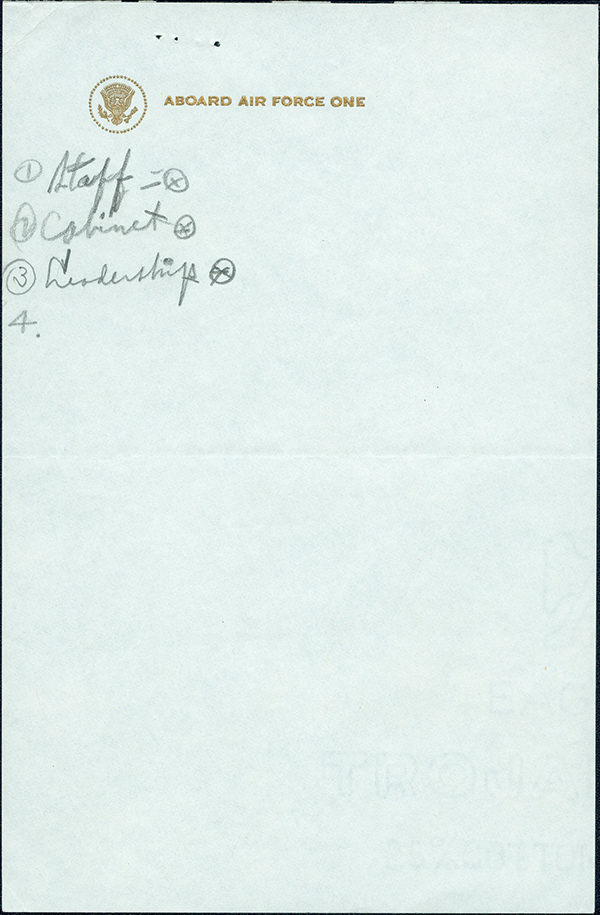
Johnson's
to-do list in the first hours of his presidency, jotted down quickly on Air
Force One, left much unsaid. (LBJ Presidential Library)
1)
Staff
2)
Cabinet
3)
Leadership
4)
That
last line sat empty, pregnant with all that he had to do.
And
so the machinery of governance began to turn. He summoned Bill Moyers to help
assign tasks. Then Johnson started working the phones, seeking out anyone who
could help.
Technology
limited communications with Air Force One. Although nine phone extensions were
onboard, only three simultaneous conversations could take place with people one
the ground. The top-of-the-line radiophone in the new Boeing 707 was a huge
upgrade to Air Force One’s telecommunications system, but it still was hard to
hold a conversation for long. “As we became airborne, I did not know what to
expect,” the signalman and radio operator, Sergeant John Trimble, later
recalled. “However, since they had to go through me, I knew that I was in for
one hell of a ride.”
Trimble
was busy every minute of the flight. “Andrews always had a waiting list of
various officials who wanted to communicate with the plane,” he said. “Many
times I had to decide with whom we would talk next.”
Each
phone call was a struggle, the communications channel full of static and with a
significant transmission lag. A typical conversation required lots of repeating
and confirming that the other party had actually understood the transmission.
“You
get that, operator?”
“Air
Force One, Andrews. Say again, please.”
“.
. . Helicopter . . . .”
“You
getting that?”
“Negative.”
“Let’s
try them again.”
As
Trimble summed up: “People talking to and from Air Force One on November 22
showed a great amount of patience.”
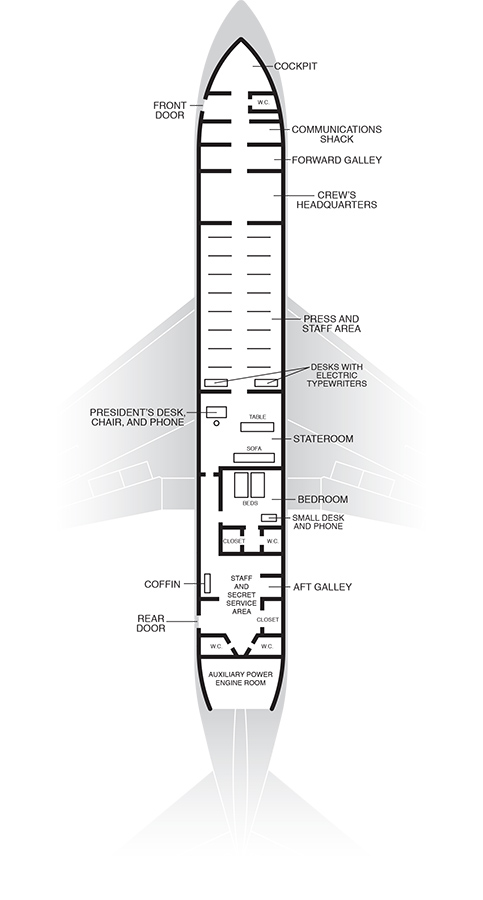
This
schematic shows the layout of Air Force One as it was on November 22, 1963.
The
new President’s calls, though, always took precedence. In stark contrast to
later claims that Johnson had grabbed for power, one of his first orders of
business was to reach out to the wounded.
Air
Force One was somewhere over
“Yes,
Mr. President?” she said, formally—addressing the man with the title that
until two hours earlier had belonged to her son.
“Mrs.
Kennedy, I wish to God that there was something I could say to you, and I want
to tell you that we’re grieving with you,” he said.
“Thank
you very much. That’s very nice. I know you loved Jack and he loved you,”
she replied warmly but formally.
“If
there is anything we can do—” Lady Bird began. Then the two women’s words
tripped over each other.
“Thank
you, Lady Bird. Thank you, Mr. President,” Mrs. Kennedy said, ending the call.
The
couple’s next call was back to
“Can
you hear me?” Lady Bird asked Nellie Connally. “The surgeon speaking about
John was so reassuring. How about it?”
“The
surgeon that just finished operating said that John is going to be all right
unless something unforeseen happens,” Mrs. Connally reported.
“I
know that everything’s going to be all right,” said LBJ, who in fact knew no
such thing.
“Yes,
everything’s going to be all right,” Lady Bird added.
“Good
luck,” Mrs. Connally wished the new First Couple.
As
the President worked his way through his calls, inbound messages stacked up.
Four times, Tazewell Shepard, Kennedy’s naval aide back at the White House,
tried unsuccessfully to reach Air Force One. And the White House communications
team tried several times to put through a condolence message from Queen
Elizabeth. They finally passed it along—in addition to three or four other
calls from heads of state—to General Clifton’s aide to give LBJ when he
arrived at the White House later that night.
Not
all of the radio traffic, though, involved the President or covered matters of
the highest urgency. Congressman Thomas, for instance, realized that no one was
expecting him in Washington—he had been scheduled to stay in Texas a few days
longer—and needed a favor from his staff.
“I
need Capital 4-3121 extension 493,” Trimble radioed to the White House.
“I’ll talk to anyone there.”
“Say
again?” the White House switchboard replied. “It was Capital 4-3291
extension 493?”
“That’s
4-3121 extension 493.”
“Roger,
roger. Understand. Anyone in particular there?”
“Roger.
Anyone at that number.”
“Roger.
Stand by.” Long pause. “Air Force One, Air Force One from Crown. Was that
extension 493?”
“That
is affirmative. Congressman Thomas’s office.”
“Say
again the congressman’s name, as they say they have no such extension.”
“Congressman
Thomas. Tango—Hotel—Oscar—Mike—Alpha—Sierra . . . .”
“Roger,
roger, stand by,” the White House finally reported back. “Congressman
Thomas’s office on the line.”
“Roger.
This is the airplane. The congressman is requesting that you place his door keys
under the doormat of his residence. Go ahead.”
“Oh,
okay. Hello?” a confused female congressional aide replied.
“Hello,
did you hear me?”
“There
will be someone at his residence,” the aide said.
“I
understand the house will be open. And someone will be in the residence. Is that
correct?” the Air Force One signalman radioed. “Hello? I understand that the
house will be occupied. That someone will be home. Is that right?”
Finally
the White House chimed back in: “Air Force One, this is Crown, that is a
Roger. She said that there will be someone at the residence.”
“Okay.
Fine, Crown. Thank you very much,” Air Force One concluded the call.
Congressman
Thomas wouldn’t be without clean clothes.
Between
phone calls, the Air Force weather station kept the flight crew informed about
tornados around
CHAPTER 11
Johnson
plopped into one of the chairs in the stateroom and gathered Bill Moyers, Jack
Valenti, and Liz Carpenter around him. “I want you to put something down for
me to say when we land at Andrews,” he said as he sipped a glass of water.
“Nothing long. Make it brief. We’ll have plenty of time later to say
more.” During the short conversation, Valenti’s eyes were drawn to the
President’s large hands—they were absolutely steady. Valenti didn’t
understand how someone under such immense and immediate pressure could ever be
so collected. “I want to make clear that the presidency will go on,” Johnson
said.
The
three set to their own drafts, which Johnson then began to edit himself.
Normally a regular drinker, he didn’t touch any alcohol on the flight; instead
he sipped Sanka nearly the entire time.
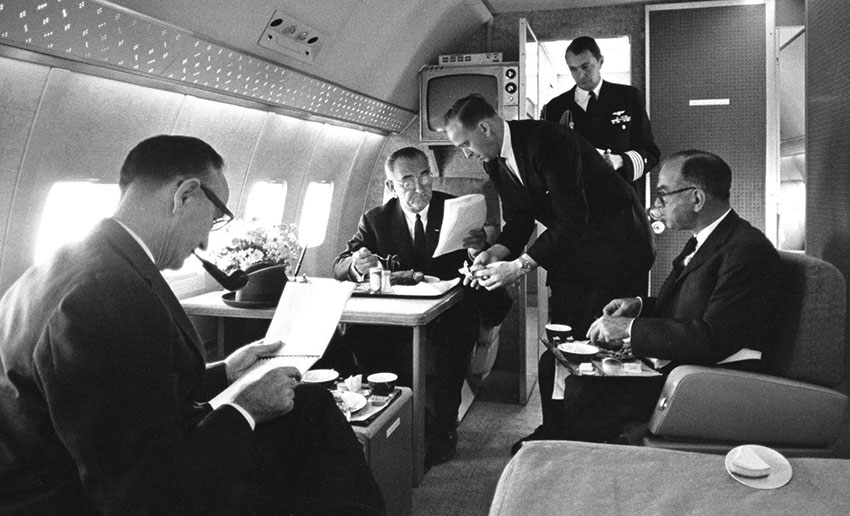
Johnson,
shown here in Air Force One's presidential bedroom on a later flight, was
immediately uncomfortable in the room when he arrived on the plane November 22,
1963. Serving LBJ is Chief Master Sergeant Paul Glynn, Johnson's Air Force
valet. (U.S. Air Force photo)
Meanwhile,
Marie Fehmer busily took dictation from passengers as they recounted the day’s
events, each of them trying to piece together more than just snapshots of
trauma. Congressman Brooks remembered hearing the three shots. Johnson aide
Cliff Carter recalled Ken O’Donnell entering the room at
The
plane’s arrival at Andrews preoccupied LBJ. Even as aides cautioned that Air
Force One’s landing should be conducted secretly, Johnson wanted a standard
press arrival. It mustn’t, he said, “look like we’re in a panic.” Everything must be normal.
“It’s
the Kremlin that worries me,” Johnson said later, sitting at the stateroom
desk. “It can’t be allowed to detect a waver.” He had seen Kennedy
humiliated at the Vienna Summit early in his own presidency; he couldn’t show
the same weakness. “Khrushchev is asking himself right now what kind of man I
am. He’s got to know he’s dealing with a man of determination.”
Johnson,
after all, was a
man of determination. Once the Senate majority leader and among the most
powerful people in
He
had been a good soldier, fiercely loyal to Kennedy, all anyone could ask of a
Vice President. Yet there had already been talk that Johnson might be dumped
from the ’64 ticket.
Just
that fall, the TV show Candid Camera had used the Vice President’s increasing
obscurity to comedic effect, asking random people: “Who is Lyndon Johnson?”
Everyone demurred; one man suggested the questioner look in a phone book.
Just
that fall, the TV show Candid Camera had
used the Vice President’s increasing obscurity to comedic effect, asking
random people: “Who is Lyndon Johnson?” Everyone demurred; one man suggested
the questioner look in a phone book. Others guessed a baseball player or an
astronaut. No one correctly identified the man who was now leader of the free
world, the man who had suddenly after three rifle shots assumed control of the
largest weapons arsenal in the history of the planet, the man now huddled in the
sitting room of Air Force One with just two hours until he had to introduce
himself to the world and reassure a devastated nation.
Before
Now
he was king. For as John Adams had said, there was but one piece of magic in the
otherwise most worthless job in
Johnson
had wanted to be President more than anything.
But
he hadn’t wanted it like this. Not with his leader’s murder. Not even Lyndon
Johnson was that hungry for power.
Now
he and his wife were entering a new world. Lady Bird had never even seen the
inside of Air Force One before boarding it to fly back to
It
was an instant transition and transformation difficult for nearly anybody in the
country to grasp, especially the four dozen people on Air Force One who had lost
a friend, a boss, and a commander. Yet even far removed from their leader and
the situation on that plane, the nation ground to a stop as word of Kennedy’s
assassination spread.
In
JFK’s
murder stunned the world like few other events in modern times. Sir Laurence
Olivier stopped a performance at
As
presidential historian Henry Graff put it later: “Lyndon Johnson’s ascent to
the presidency came at the most traumatic moment in American political
history.”
CHAPTER 12
Charles
Roberts and Merriman Smith, the two reporters aboard the plane, worked
frantically to write their stories using scrounged supplies and borrowed
typewriters. Aides and officials stopped by their workspace to whisper details
or offer memories of the day. Brigadier General McHugh made one trip forward to
remind them that he’d otherwise stood guard by the casket throughout the
journey. Mac Kilduff passed along decisions as the staff made them, and
President Johnson himself stopped by the newsmen’s table at one point to
explain that he intended to ask the Kennedy Cabinet to stay on.
“We
had so darn much work,” Newsweek’s Roberts
said later. “This was the only time in my life that I ever felt like saying to
a President of the
In
the main staff cabin, Roberts tried to ask Roy Kellerman some details of the
shooting but couldn’t bring himself to interrogate the Secret Service agent
for long. “His eyes were brimming,” Roberts later said, and Kellerman was
far from alone: Many “strong men [were] crying on the plane that day,”
Roberts recalled.
Next
to Roberts, Merriman Smith—the mustachioed 50-year-old UPI wire correspondent
known to everyone as “Smitty”—was trying to hide his inner turmoil as the
day’s events unfolded. He had broken the news of JFK’s shooting—the 15
bells that had rung in every newsroom in the country alerting editors to his
urgent FLASH from the motorcade press car: “Dallas, Nov. 22 (UPI)—THREE
SHOTS WERE FIRED AT PRESIDENT KENNEDY’S MOTORCADE IN DOWNTOWN DALLAS.
JT1234PCS—”
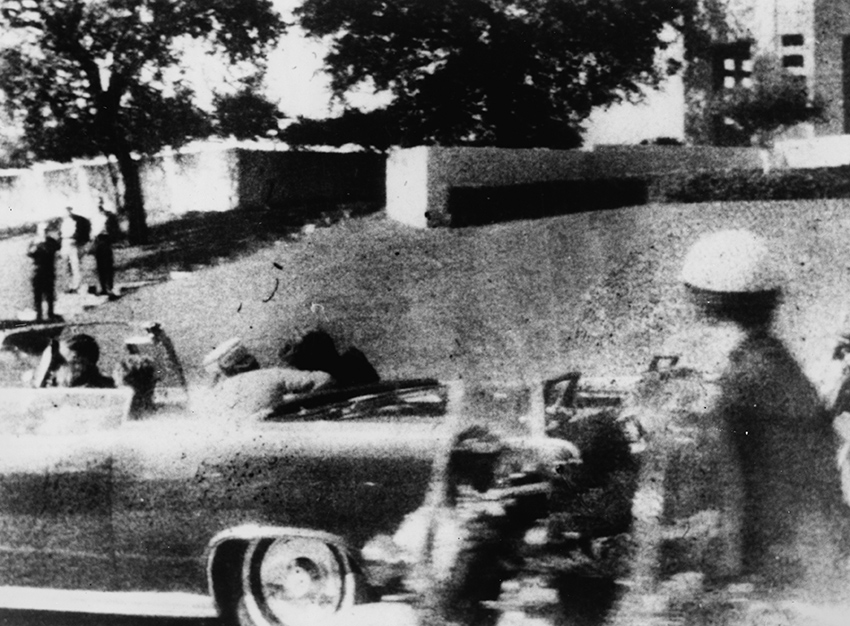
The
work that day of Merriman Smith, one of the two journalists aboard Air Force
One, would earn him the Pulitzer Prize. (Photo by Mary Moorman/Wikimedia
Commons)
Then
just five minutes later: “FLASH FLASH KENNEDY SERIOUSLY WOUNDED PERHAPS
SERIOUSLY PERHAPS FATALLY BY ASSASSINS BULLET JT1239PCS.” Then more.
Within
11 minutes of the shooting, Smith had dictated a 500-word story. He’d been
feeding updates to UPI about the President’s death when Secret Service agent
Rufus Youngblood stopped him in the
The
reporter’s work that day would earn him a Pulitzer Prize. Sadly, this flight
was now his second trip back to
“In
JFK’s death,” he wrote in his diary a year later, “my sense of loss had
taken the form of simply being unable to accept in my guts the coarse image and
patois of LBJ.”
At
times, it was as if there were two entirely different plane trips in progress.
The
front of the aircraft was a hive of activity—Johnson aides and military and
press officials scrambling for free radio time, workspace, and typewriters as
they tried to report, assemble, and organize a government from miles above the
earth. The rear, though, often seemed like the tomb it was, or an airborne Irish
wake.
The
trio of Kennedy aides whom the President had always jokingly called “the
clowns”—O’Donnell, Powers, and O’Brien—joined Jackie there. There was
little additional room in the aft compartment, so the other Kennedy aides were
left to visit one at a time: Jackie’s press aide, Pamela Turnure; JFK
secretary Evelyn Lincoln; and Secret Service agent Clint Hill. As they flew
north, O’Donnell encouraged Jackie to have a Scotch. “I’m going to have a
hell of a stiff drink,” he said. “I think you should, too.”
“I’ve
never had Scotch in my life,” she replied, then paused. “Now is as good a
time to start as any.”
But
she barely touched the whisky. (Jackie drank only Scotch in the months ahead.
She never once liked it, but it reminded her of the pain of that flight—a pain
she didn’t want to forget.) The aides, though, took to the bottle with
abandon.
Seated
around a small table, one of the only things in the space not removed to fit the
casket, they drank and drank. “It was like drinking water,” O’Donnell
recalled. “It left us cold sober.”
Their
drinking, though, made an impression on the new President, and not a favorable
one. “I thought they were just wineheads,” Johnson said in a 1969 interview.
“They were just drinkers, just one drink after another coming to them trying
to drown out their sorrows. It was a peculiar situation that they sat back in
the back and never would come and join us.”
LBJ
asked O’Donnell three times to come forward to speak with him, but the Kennedy
aide refused to budge. “I sat with her the entire trip,” he said of Jackie
Kennedy. “She just wanted to talk. She talked the entire way.” They
reminisced about the President, about the family, about the Kennedy family home
in
“You
were with him at the start, and you’re with him at the end,” Jackie said to
Powers and the others.
She
was also already doing her own thinking.
The
former First Lady was so far from her two children, so eager to be
home—wherever home would now be after she moved out of the residence that she,
her husband, and their children had known for the last two years. In some ways,
she and JFK had never been closer than at the moment of his death.
Their
marriage had strengthened and blossomed in the preceding months, the loss of
newborn baby Patrick in August—their second child to die, after Arabella was
stillborn in 1956—having brought the couple closer together. She had been
gearing up for the campaign;
The
couple hadn’t even slept together the night before; the hard mattress the
President brought along on road trips was big enough for only one. She had slept
in the other bedroom of their three-room hotel suite. “You were great
today,” he had said before they went their separate ways at bedtime.
Yet
she was holding it together—barely.
“That
frail girl was close to composure, bringing to the surface some strength within
her while we three slobs dissolved,” O’Brien said later.
Jackie
began to plan. She remembered how her husband had loved Luigi Vena’s singing
and decided that the Italian tenor should sing “Ave Maria” at the funeral.
Next she determined that Cardinal Richard Cushing, the archbishop of
Dave
Powers and Ken O’Donnell recalled visiting the grave of the couple’s
deceased son, Patrick, the previous month in
“I’ll
bring them together now,” Jackie said, the plans already forming in her mind.
Her husband would be buried at
Conversations
were halting; starting, stopping, and then restarting, overlapping. Evelyn
Lincoln, at a loss for words, said, “Everything’s going to be all right.”
Jackie
just looked at her: “Oh, Mrs. Lincoln.”
Throughout
the flight, no one touched what Jackie called “that long, long coffin.” Mary
Gallagher resisted leaning over to kiss it. The others around her—O’Brien,
O’Donnell, and Powers—sat vigil, many of them lost in their own thoughts, of
both remembrance and guilt: O’Donnell, speaking to the Secret Service that
morning, had given the order to leave the armored bubble top off the
presidential limo. (“Politics and protection don’t mix,” he had told the
White House security chief, Jerry Behn, during one argument.)
At
one point, Jackie Kennedy mused openly that her husband had been martyred like
Abraham Lincoln. It was a theme the Kennedy people returned to again and again
as their conversations—half wake, half plans—unfurled like the fields
passing far below.
Jackie
already worried about her husband’s legacy. He had been such a student of
history. What would history now say about him? Not knowing that mere feet from
her the UPI reporter was grieving deeply for her husband—holding LBJ’s
accidental presidency against him even in its first hours—she worried about
how the emotion-prone journalist would record the day: What is history going to see in this except what Merriman Smith
wrote, that bitter man.
CHAPTER 13
When
the two camps collided, emotions—anger, fear, grief, often
interconnected—ran high.
“Why
don’t you get back and serve your new boss?” O’Donnell barked at General
Clifton at one point when the intelligence aide came to the rear to ask a
question.
“What’s
eating him? I’m just doing my job,”
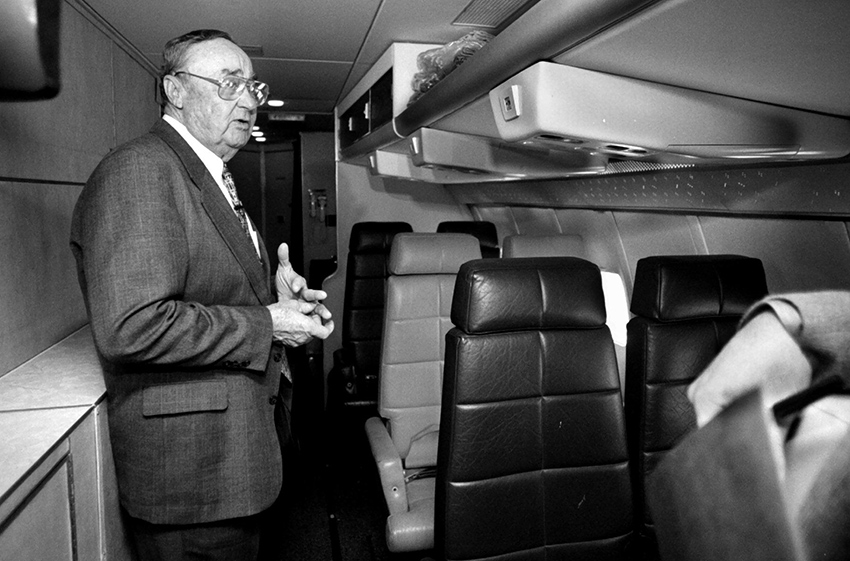
Chief
Master Sergeant Joe Chappell, who was the flight engineer on Air Force One when
Kennedy was assassinated in
“To
be the confidant and trusted emissary of the President, and now, by a freakish,
ghoulish act of assassination to be isolated, alone, adrift, with the captain
missing and a new helmsman in charge, this abrupt transition could not be
handled by mere mortals,” Jack Valenti wrote later. “I didn’t see
hostility. All I saw was grief—bitter, dry-teared grief.”
O’Donnell
concurred: “Whatever resentment some of us might have felt, neither Dave
[Powers] nor I remember any open display of antagonism against Johnson.”
Up
front, Kilduff drank gin-and-tonics. He later estimated that he downed
two-thirds of a bottle of gin while single-handedly juggling the duties of an
entire press office.
“I
needed that White House staff,” Johnson said later. “Without them I would
have lost my link to John Kennedy, and without that I would have had no chance
of gaining the support of the media or the Eastern intellectuals. And without
that support I would have had absolutely no chance of governing the country.”
But
he also knew he needed to be patient. Toward the end of the flight, Johnson
canceled the staff meeting he had planned upon returning to
“All
of us tried to comfort them in a quiet way, but they were still dazed from the
whole thing,” Johnson aide Liz Carpenter explained. When Moyers went back at
one point to ask for O’Donnell’s help on a matter, O’Donnell looked at him
blankly: “Bill, I don’t have the stomach for it.”
And
that was that. That night in
General
Ted Clifton called national-security adviser McGeorge Bundy to plan for the
President’s arrival. “Two meetings tonight—[Secretary of Defense Robert]
McNamara and Bundy and the leadership about 7:30,”
“Does
he mean the Democratic leadership only?” Bundy asked.
“Bipartisan
leadership, and I’ll give you some names,”
Bundy—who
referred to Johnson as “the Vice President” throughout the conversation out
of habit—suggested that because the Cabinet Room was being rearranged and
might not be ready in time, they should plan to meet with the congressional
leadership in the Oval Office. But
“He
does not want to go into the mansion or in the Oval Room or the President’s
Office or the President’s Study. So if the Cabinet Room isn’t ready, then
put it in the Fish Room,”
“All
right, I will,” Bundy said.
Given
how carefully LBJ, even in the midst of a national crisis, orchestrated the
power shift to lessen the pain of the Kennedy camp, he was stung by the
accusations voiced four years later in William Manchester’s book that Johnson
had brazenly seized the crown, shoving aside the grieving Kennedy team. “I did
everything I could to show respect and affection and grief to Mrs. Kennedy,”
LBJ said later. “I don’t know of any niceties that were overlooked at all,
and what’s more, I think everybody in the party will say that.”
CHAPTER 14
On
the flight, the Secret Service pushed their new President to spend the night in
the White House. It was safe there, they knew, and Rufus Youngblood urged him
“to think of security first.”
But
Johnson cut off the conversation: “We are going home to The Elms. That’s
where we live. If you can protect us at the White House, by God you can protect
us at home, too.” He did not want to seem presumptuous.
Because
the Vice President of the United States didn’t have an official residence at
that time—and wouldn’t until a house on the grounds of the Naval Observatory
was designated as such in 1974—Johnson had commuted in to the White House each
day from the Spring Valley neighborhood. (His home at
His
orders clear, Youngblood squeezed himself into the plane’s communications
shack to call the White House security chief. The connection, again, was patchy
at best—beset with static and garbled transmissions and packed with code
names.
What
are commonly known as “Secret Service code names” are actually designations
given by the White House communications agency to officials and their families
and are grouped around the same letters: All the Kennedy family names began with
L: Lancer for JFK, Lace for Jackie, Lyric for Caroline, and Lark for John Jr.
The Johnson family had received V names: Volunteer for
“I
committed about 50 to memory and instructed others to use their last name,”
radioman Trimble recalled later. Then there were separate code names for major
destinations: Crown was the White House, Valley the Vice President’s residence
at The Elms. “Originally, the code names were a good idea and did facilitate
communications, but like most everything else in government, [they’ve] gotten
out of hand,” Trimble recalled. It was a lot to keep straight in a
conversation.
“Volunteer
will reside at Valley for an indefinite time,” Youngblood transmitted. “I
repeat: Volunteer will reside at Valley for an indefinite time.
“Will
you say again?” Jerry Behn asked from the White House. “Will you say
again?”
“Venus
should go out to Valley with agent,” a White House operator, also on the line,
tried to clarify.
“That
is a roger,” Youngblood said, sounding very far away from his colleagues at
just the moment they needed to be working closely together. “That is a roger.
Venus will go to Valley with agent.
“
“Okay,
that’s affirmative,” Behn said, but Youngblood still wasn’t sure the White
House had actually heard the main piece of information he was trying to convey:
The Secret Service had only a few hours to be ready for the President of the
United States to live outside the White House indefinitely for the first time
since Harry Truman had moved to Blair House during a post–World War II
renovation.
“Do
you also understand that for residential purposes Volunteer will reside at
Valley?” he asked.
“That
is affirmative,” Behn said, understanding. There was another short pause
before Behn repeated for emphasis, “That is affirmative.”
Youngblood
signed off: “All right—that is all the traffic I have at present.”
A
few minutes passed, and then a further thought from Air Force One. The plane
called back to the White House: Now that Johnson was President, the public
telephone line at his house—the one that was in the phone book—should be
disconnected and new, secure phones installed.
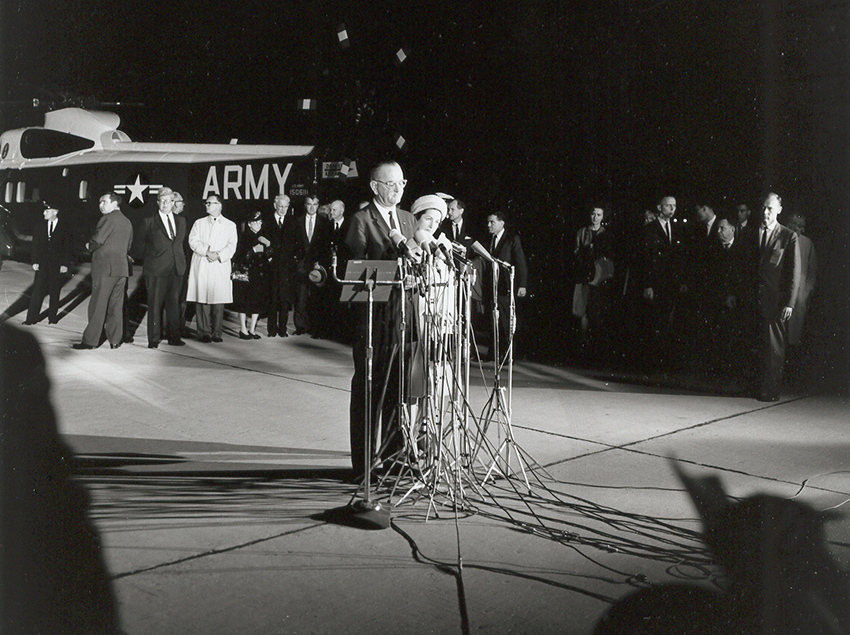
The
tarmac at Andrews Air Force One would be the first time Johnson presented
himself to the world as President of the
LBJ
also talked to McGeorge Bundy directly throughout the flight, attending to what
seemed to be a growing list of matters of state. Johnson was hungry for details
of the unfolding assassination investigation. Half an hour after takeoff, word
had come that a
American
military commanders around the world were moving their forces to a higher state
of readiness, but neither Bundy nor Johnson advocated a general alert or a move
to a higher so-called DEFCON.
Kilduff
and Valenti made several trips to the rear of the plane to ask if anyone needed
anything. The Kennedy men and Jackie barely acknowledged them. At one point, she
looked at Clint Hill—the Secret Service agent whom she had helped clamber onto
the trunk of the presidential limousine as it began to speed from the shooting
scene—and asked, “What will happen to you now?”
Around
5 pm, Admiral George Burkley, Kennedy’s physician, spoke with the Secret
Service and the military aides, realizing that one of the hardest conversations
of the trip fell to him. He passed through the President’s sitting room and
entered the silent, hallowed rear compartment to kneel next to the widow, her
Scotch before her on the table. He explained that her husband would have to be
autopsied.
“Why?”
“The
doctors must remove the bullet—the authorities must know the type. It becomes
evidence.”
“Well,
it doesn’t have to be done,” she said.
“Yes,
it is mandatory that we have an autopsy,” explained the admiral, who had
served as Kennedy’s doctor since the second month of his administration. “I
can do it at the Army hospital at Walter Reed or at the Navy hospital at
Burkley
hoped he could arrange it at a military hospital—the commander in chief
deserved that, and it would be the most secure facility possible. But in that
moment he was willing to indulge almost anything Jackie wanted. She thought for
a minute and then chose
General
McHugh later knelt beside her and asked again if she’d like to change clothes
before landing. She said what she’d said in
Someone
else suggested that Jackie could deplane on the right side of the aircraft, away
from the press and the television lights.
“We
will go out the regular way,” she said.
Ted
Clifton volunteered that an Army honor guard would be ready to carry the
President off the plane, but Jackie stopped him: “I want his friends to carry
him down.”
She
summoned Roy Kellerman, the head of JFK’s detail, and Dave Powers explained
that the Secret Service agents who were with the President would bear him off
the plane. Mrs. Kennedy wanted Bill Greer, his driver, to drive the ambulance.
Greer, who had spent the plane ride replaying in his mind the turn onto
General
Chester Clifton was known to most of his friends as Ted, but for official
purposes he was code-named Watchman. After Kellerman had arranged for the
autopsy,
“This
is Watchman,” he radioed Behn, the White House security chief. “I understand
that you have arranged for an ambulance to take President Kennedy to
“It
has been arranged to helicopter the body to
“Okay,
if it isn’t too dark. What about the First Lady?”
“Everyone
else will be helicoptered into the South Grounds.”
“Are
you sure that the helicopter operation will work? We have a very heavy
casket.”
“According
to Witness [naval aide Tazewell Shepard], yes.”
“Don’t
take a chance on that,”
“Affirmative.”
“Now
some other instruction. Listen carefully: We need a ramp put at the front of the
aircraft on the right-hand side just behind the pilot’s cabin in the galley.
We are going to take the First Lady off by that route.”
“Understand.”
“Also,
at the left rear—at the rear of the aircraft where we usually dismount, we may
need a forklift rather than a ramp. A platform to walk out on and a forklift to
put it on. The casket is in the rear compartments, and because it is so heavy we
should have a forklift there to remove the casket. If this is too awkward, we
can go along with a normal ramp and several men.”
“Affirmative.
We will try for the forklift.”
“Next
item,”
“Should
the Secretary of Defense and others be at Andrews on your arrival?”
“No,”
“Affirmative,”
Behn said from the ground, but
“Repeat
that to me.”
“All
the leaders of Congress, as many Cabinet members as possible at the White House
at 1830.”
“And
key members of the White House staff—[Ted] Sorensen, Bundy, et cetera,” he
trailed off, then prepared to hand the call over to the head of Kennedy’s
Secret Service detail. “Hold for Kellerman.”
“Have
helicopter to transport President Johnson and party to the White House lawn,”
Kellerman commanded Behn, who technically was his boss.
“Affirmative.”
“Have
White House cars 102 and 405 for transportation to hospital,” Kellerman said.
“I will join [agent Clint] Hill and party at the Navy hospital.”
CHAPTER 15
Two
hours after leaving behind the city that had killed Kennedy, Colonel Swindal
began his descent, swinging east over Middleburg toward the lights of DC in the
distance.
Johnson
excused himself from the group and stepped into the presidential bathroom. He
gave himself a quick shave and combed his hair, wanting to present a polished
look to the world as it gazed upon the new President for the first time. He put
on a fresh shirt, straightened his tie, and put his suit jacket back on. The man
whom critics thought too unpolished, too crude, too brusque to lead a nation
stared at himself in the mirror: Was this presidential enough?
Air
Force One glided home, over the Potomac River and a capital already in mourning,
a distant yellow light resolving into an airplane as it neared the runway and
the thousands of eyes searching the night sky for the first glimpse of the
majestic hearse. Up and down the East Coast, commercial planes circled in
midflight, diverted to clear a path for the presidential aircraft.
Colonel
Swindal eased it onto the runway, the back wheels touching down first with a
puff of white smoke, then the front, then the braking as Air Force One slowed to
a stop. Reporter Charles Roberts looked up from typing the final pool report
that would be handed out to the media. He checked his watch.
It
was 5:59 pm in
The
35th and 36th Presidents of the
A
military honor guard stood ready on the tarmac along with a Navy ambulance and a
catering truck to lower the casket from the plane.
The
press were all arranged with their microphones set, the TV lights ablaze.
Diplomats had arrived en masse, as had the public, who gathered by the thousands
outside the gates at Andrews. US government and military officials stood
uneasily in the darkness. Senators Everett Dirksen, Hubert Humphrey, and Mike
Mansfield waited near the press area. Nearby, helicopters were poised to whisk
the President, the new First Lady, and her widowed predecessor across to
“Crown”—the White House, the home that for the moment seemed to belong to
neither the Johnsons nor the Kennedys.
As
he stood to disembark, Johnson’s massive hand clenched a small piece of aboard
air force one notepaper printed with the presidential seal— his seal
now—with seven typed sentences to read to the press below, the sum total of
his staff’s wisdom during the preceding flight. He had thoughtfully edited the
statement, making changes to nearly every sentence, adding personal touches to
the cold words on the page, changing, for instance, “the nation” to
“we.”
Instead
of a joke at the podium in Austin about his charismatic leader having survived
the trip to Dallas, his final public words of the day would now be to claim
control of a tragedy in his leader’s absence and to reassure a nation that he,
Lyndon Baines Johnson—the poor boy from the Texas hill country who had
graduated from Southwest Texas State Teachers College—stood ready to inherit
command.
The
words were hard to read, and he would stumble over them, trying to decipher in
the cool
“This
is a sad time for all people. We have suffered a loss that cannot be weighed.
For me it is a deep personal tragedy. I know the world shares the sorrow that
Mrs. Kennedy and her family bears.
“I
will do my best. That is all I can do. I ask only for your help—and
God’s.”
His
plea was heartfelt. The raw power Johnson had inherited in an instant—not just
the office but ultimate control over the Polaris submarines hidden beneath the
waves, the nuclear-armed alert bombers making lazy circles over the Midwest, the
Minuteman missile crews sitting quiet vigils in their silos across the
plains—had never before been given to a man under those circumstances.
“This
is a sad time for all people. We have suffered a loss that cannot be weighed.
For me it is a deep personal tragedy. I know the world shares the sorrow that
Mrs. Kennedy and her family bears.
History’s
trajectory had been altered, and the world now waited to see what would come
next. Ahead lay the unknown pressures of the Cold War, Fidel Castro, and Nikita
Khrushchev; the drama of Martin Luther King Jr., a bridge in
The
1960s were poised to upend American life outside Air Force One. The accidental
group of passengers brought together for this flight—all the friends, all the
strangers, all the enemies, all the allies—would in the minutes and hours
ahead disperse, never to reconvene. A decade later, the same airplane, SAM
26000, would fly Lyndon Johnson home to
But
all of that lay in the future.
For
one last minute, as the stairs were brought forward, the plane and its
emotionally spent occupants stayed silent. “Let’s get everybody together,”
Johnson said, and the passengers clustered in the rear—the Kennedys closest to
the door with the casket, then Johnson, then his aides and the congressmen
behind him. Johnson reached through the crowded aisle to kiss the hand of
Kennedy aide Pam Turnure.
Then,
as those inside waited for the back door to open, a murmur passed through the
length of the aircraft: The attorney general had boarded unexpectedly through
the front door. Robert F. Kennedy, his face streaked with tears, ran through the
communications shack staffed by the exhausted radioman Sergeant Trimble, passed
through the forward galley with its depleted liquor cabinet, pushed his way
through the crowded staff area where LBJ and Jackie had stood earlier with Judge
Sarah Hughes, past the secretaries and the typewriters that just hours before
had written out the oath of office, and through to the President’s cabin.
“Excuse
me, excuse me,” he said, pushing through the knots of people. “Where’s
Jackie? I want to be with Jackie.”
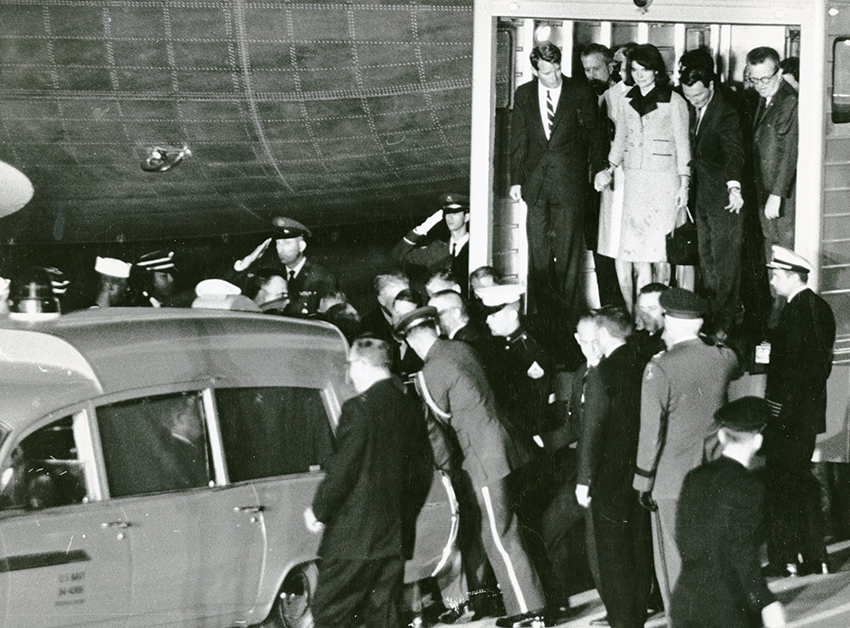
Bobby
Kennedy helped his brother's widow off the plane at Andrews Air Force Base.
(Photo via MLK Library)
As
Bobby Kennedy stepped into the President’s cabin, the new President of the
His
voice weighed down with emotion, Lyndon Johnson greeted RFK simply: “Bob.”
But
the attorney general never broke stride, pushing right past his new boss, past
everyone until he reached his brother’s widow, standing next to the bronze
casket with the broken handle.
Her
brown eyes turned toward him.
“I’m
here,” he said.
“Oh,
Bobby,” she said.
They
hugged.
And
the rear door of Air Force One opened.
